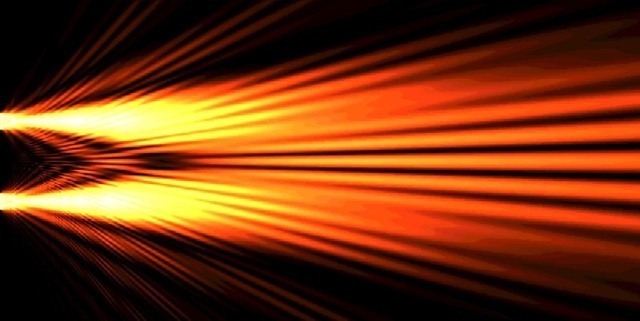
One of the deepest mysteries in quantum physics is the wave-particle duality: every quantum object has properties of both a wave and a particle. Nowhere is this effect more beautifully demonstrated than in the double-slit experiment: streams of particles (photons, electrons, whatever) are directed at a barrier with two narrow openings. While each particle shows up at the detector individually, the population as a whole creates an interference pattern as though they are waves. Neither a pure wave nor a pure particle description has proven successful in explaining these experiments.
Now researchers have successfully performed a quantum interference experiment with much larger and more massive molecules than ever before. Thomas Juffmann et al. fired molecules composed of over 100 atoms at a barrier with openings designed to minimize molecular interactions, and observed the build-up of an interference pattern. The experiment approaches the regime where macroscopic and quantum physics overlap, offering a possible way to study the transition that has frustrated many scientists for decades.
The interference of waves is determined in part by the wavelength. According to quantum physics, the wavelength of a massive particle is inversely proportional to its momentum: the mass multiplied by the particle's speed. In other words, the heavier the object, the shorter its wavelength at a given speed.
A kicked football (for example) has a very tiny wavelength compared to the size of the ball because it has a relatively large mass and a speed measured in meters per second (rather than nanometers or such). In contrast, an electron has a relatively large wavelength (though still microscopic) because it has a small mass. Longer wavelengths make it easier to generate interference so, while it isn't going to be possible to make two footballs interfere with each other (in the quantum sense!), it's comparatively straightforward to produce electron interference.
The relatively large phthalocyanine (C32H18N8) and derivative molecules (C48H26F24N8O8) have more mass than anything in which quantum interference has previously been observed. To have wavelengths that are relatively large compared to their sizes, the molecules need to move very slowly. Juffmann et al. achieved this by directing a blue diode laser onto a very thin film of molecules in a vacuum chamber, effectively boiling off individual molecules directly under the beam while leaving the rest unaffected.
After separation from the film, the molecules were sent through a collimator to ensure they formed a beam before reaching the barrier, which had a number of parallel slits to produce the actual interference pattern. To prevent excessive interactions (primarily van der Waals forces) between the molecules and the edges of the slits, the researchers used a specially-prepared grating coated in silicon nitride membranes. Without such preparation, the molecules are likely to be deflected by ordinary interactions with the hardware.
After passing through the slits, the molecules' positions were recorded using fluorescence microscopy, which has both sufficient spatial resolution and fast response to detect when and where the molecules arrive. The positions of individual spots were measured to 10 nanometer accuracy. Additionally, the molecules lodged in the fluorescent screen, meaning their positions could be independently verified in the form of build-up at the experiment's end.
The researchers observed the particle nature of the molecules in the form of individual light spots appearing singly in the fluorescent detector as they arrived. But, over time, these spots formed an interference pattern due to the molecules' wavelike character.
As the Juffmann et al. point out, no other explanation but quantum interference can account for the pattern that appears in the fluorescent detector. Since the phthalocyanine and phthalocyanine-derived molecules are relatively large and massive, their behavior approaches the limits at which macroscopic properties begin to exhibit themselves. Future experiments with even larger molecules may be able to examine the transition between everyday physics, in which quantum interference doesn't play a role, and the underlying quantum world.
Nature Nanotechnology, 2012. DOI: 10.1038/nnano.2012.34 (About DOIs).
Listing image by Photograph by woodahl.physics.iupui.edu
reader comments
34